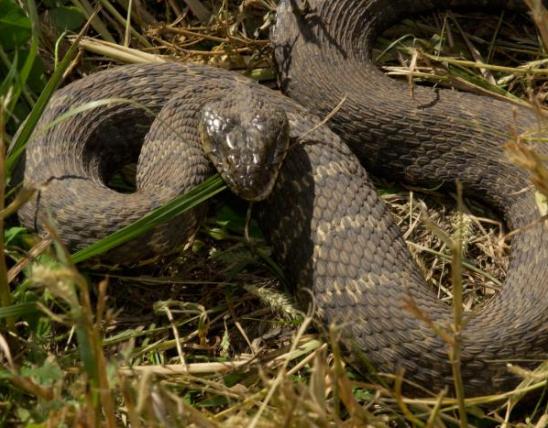
Graham's crawfish snake is a medium-sized, dull-colored, semiaquatic snake that occurs throughout Missouri, but not in the Ozarks. The ground color is brown or yellowish brown above, with a broad yellowish-tan stripe along each lower side. This yellowish stripe may be bordered by a thin dark brown line. There may be a faint tan stripe along the middle of the back. The chin and throat are often cream to yellow. The belly is cream colored or light yellow, with a faint central row of gray or light brown dots and a zigzag pattern of dark brown along both edges.
Similar species: This and other snakes that live around water are often confused with the venomous western cottonmouth. The true cottonmouth is more heavy-bodied with a larger, chunky head; has a facial pit between the nostril and eye on either side of the head; is darker; and has a light line from each eye to the corner of the mouth. Also, no western cottonmouths are known to occur north of the Missouri River in our state.
Adult length: 18 to 28 inches; occasionally to 47 inches.

Statewide, but not present in the Ozarks.
Habitat and Conservation
Graham's crawfish snake is active in Missouri from late March or April through early November, with peak activity in April–May and October. They are commonly found along the grassy edges of marshes and prairie streams.
This reclusive, semiaquatic snake often takes shelter under rocks or logs, in crayfish burrows, or in burrows it digs itself in the soft, moist soil along the edges of slow-moving prairie streams, marshes, sloughs, or ponds.
In spring and early summer, it basks among branches overhanging water. In hot weather, it becomes nocturnal or may estivate under shelter. In winter, it takes shelter in crayfish burrows.
Food
True to its name, this snake feeds mainly on freshly molted crayfish (which temporarily have soft bodies and are therefore easier to digest). They also eat frogs, salamanders, and small fish.
Status
Harmless, nonvenomous snake. Can be locally abundant, especially on remnant natural marshes with abundant aquatic vegetation and crayfish.
Life Cycle
Mating occurs in April and May. Females give birth to live young from late July through September. Litters may contain 4–39 young. Males become sexually mature at one year of age, while females can take up to three years to become mature enough to reproduce.
Human Connections
If captured, this snake generally does not bite but usually releases a foul-smelling musk mixed with feces.
Although in its general color and appearance, this snake looks nothing like a cottonmouth, it is often misidentified as one and summarily slain. Crawfish snakes are harmless to us. Our many misconceptions about snakes arise from fear that we acquire at an early age. Knowledge corrects our prejudice.
Graham’s crawfish snakes are difficult to keep in captivity due to their specialized diet (soft-bodied crayfish).
This species is named in honor of James Duncan Graham (1799–1865), who collected the original (type) specimen used to describe the species. He was a surveyor and early member of the U.S. Army Corps of Topographical Engineers. He surveyed the lands on Stephen Long's expedition to the Rocky Mountains in 1819–1821. He later helped survey the border with Mexico; Arizona's Mount Graham, and thus its Graham County, is named after him. He documented the presence of lunar tides in the Great Lakes, and he oversaw the seawalls in Boston harbor and other harbors on the east coast. A Jamaican anole and a patchnose snake are also named after him.
Ecosystem Connections
The fortunes of Graham's crawfish snake are closely tied with its particular habitat and prey. Keeping this species common in Missouri requires protecting and restoring wet prairie habitat that are near marshes, swamps, and streams. Such habitat supports high densities of crayfish necessary for food and crayfish burrows for shelter.
As predators, crawfish snakes control populations of the crayfish and other animals they consume. As with many other predatory species, they can be preyed upon themselves by larger animals, including mammals and predatory birds. The newborn young are especially vulnerable.

































